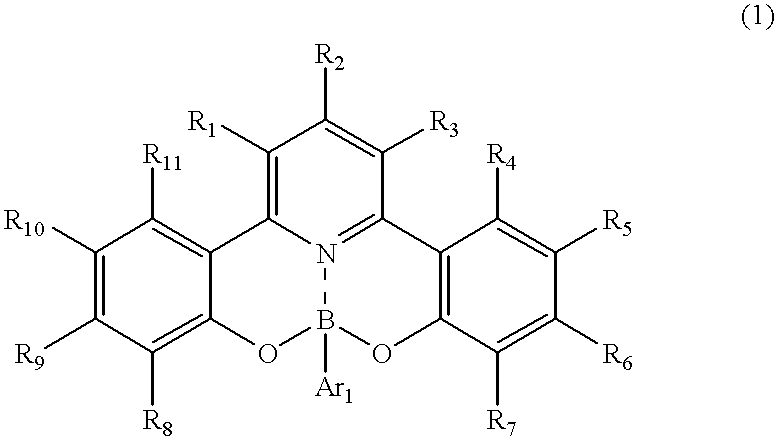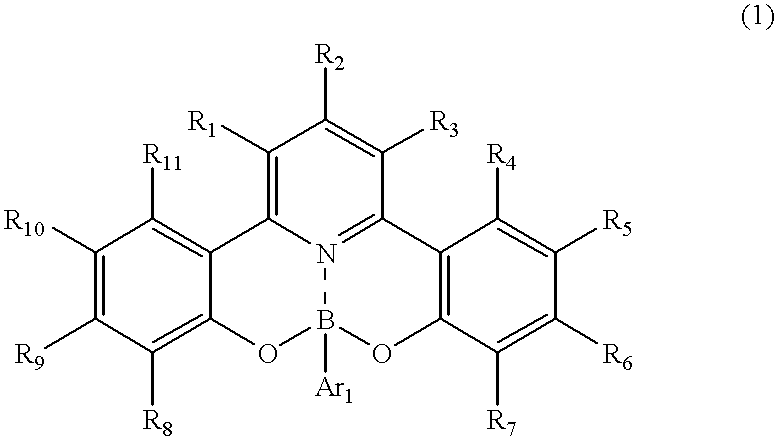Novel organic boron compound, process for producing the compound and organic luminescnece device using the compound
a luminescnece device and organic technology, applied in the direction of luminescnet screens, natural mineral layered products, organic compounds of group 3/13 elements, etc., can solve the problems of deterioration, affecting the durability of luminescence devices, and affecting the quality of luminescence devices
- Summary
- Abstract
- Description
- Claims
- Application Information
AI Technical Summary
Benefits of technology
Problems solved by technology
Method used
Image
Examples
example 2
[0090] The above-listed example compound No. 16 was synthesized in the following manner. 1.63 g (5 mmol) of 2-hydroxyphenacyl-pyridinium iodide, 0.53 g (2 mmol) of 1-(2-hydroxyphenyl)-3-(4-dimethylaminophenyl)-2-propen--1-one and 4 g of ammonium acetate were added to 4 ml of acetic acid, and the mixture was subjected to refluxing under heating for 5 hours. After being cooled to room temperature, the reaction mixture was poured to 50 ml of water and extracted two times with 30 ml each of chloroform. The chloroform was distilled off under a reduced pressure, and the residue was subjected to silica gel column chromatography with chloroform as the eluent to obtain 0.61 g (yield: 79%) of 2,6-bis(2-hydroxyphenyl)-4-(4-dim-ethylaminophenyl)pyridine. (Incidentally in case where the reaction residue was subjected to re-crystallization from 30 ml of ethanol, the 2,6-bisphenolpyridine product was recovered at a yield of 64%.)
[0091] Then, 0.38 g (1 mmol) of the 2,6-bis(2-hydroxyphenyl)-4-(4-dim...
example 3
[0093] The above-listed example compound No. 17 was synthesized in the following manner.
[0094] 0.35 g (1 mmol) of 2,6-bis(o-hydroxyphenyl)-4-(p-methylphenyl)pyrid-ine was dissolved in 30 ml of acetic acid, and 0.15 g (1.25 mmol) of phenylboric acid was added thereto, followed by stirring at room temperature to result in a precipitate within ca. 10 min. The stirring was continued for 8 hours, and the precipitate was recovered by filtration and washed with water until the washing liquid became neutral, thereby obtaining 0.32 g (yield: 74%) of substantially pure phenylboric acid ester of 2,6-bis(o-hydroxyphenyl)-4-(p-methylphenyl)pyridine.
[0095] The reaction scheme is represented as follows. 20
example 4
[0096] An organic boron compound of a structure as shown in FIG. 2 was prepared in the following manner.
[0097] A 1.1 mm-thick glass substrate coated with a 120 nm-thick film of ITO (indium tin oxide) formed by sputtering was successively washed with acetone and isopropyl alcohol (IPA) under application of ultrasonic wave and then washed with IPA under boiling, followed by cleaning by UV / ozone (i.e., irradiation with ultraviolet rays in the ozone-containing atmosphere), to obtain a transparent conductive substrate (including a substrate 1 and an ITO anode 2 formed thereon).
[0098] The transparent conductive substrate was coated by vacuum deposition first with N,N-diphenyl-N,N'-m-tolyl-4,4'-diamino-1,1'-bipheny-l (hereinafter called "TPD") (hole-transporting material) in a thickness of 500 .ANG. (layer 5), then the above-listed
[0099] Compound No. 2 in a thickness of 500 .ANG. (layer 6) and then Al in a thickness of 1500 .ANG. (cathode 4) to prepare a luminescence device. The device cau...
PUM
| Property | Measurement | Unit |
|---|---|---|
| Ratio | aaaaa | aaaaa |
Abstract
Description
Claims
Application Information
 Login to View More
Login to View More - R&D
- Intellectual Property
- Life Sciences
- Materials
- Tech Scout
- Unparalleled Data Quality
- Higher Quality Content
- 60% Fewer Hallucinations
Browse by: Latest US Patents, China's latest patents, Technical Efficacy Thesaurus, Application Domain, Technology Topic, Popular Technical Reports.
© 2025 PatSnap. All rights reserved.Legal|Privacy policy|Modern Slavery Act Transparency Statement|Sitemap|About US| Contact US: help@patsnap.com



